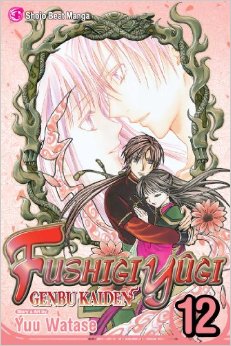Fushigi Yugi Genbu Kaiden, Vol 12 by Yuu Watase
I’m sure it sounds odd, but I was actually a bit nervous about picking up the final volume of this series that I’ve been enjoying so much, simply because I’ve been a bit frightened of the ending. I knew that plenty of deaths would be occurring. This is no big secret, since the heroine Takiko has been dying of tuberculosis throughout the series, and the presence of a couple ghostly Genbu Celestial Warriors in the first Fushigi Yuugi series gave enough hints towards inevitable tragedy that a certain air of melancholy has hung over this manga, giving it an additional theme that has offset all the fantasy adventure I’d expect from a Yuu Watase series.
When I put this volume down, I realized I was wrong to be nervous, because the ending was the best one possible given the set of circumstances the characters found themselves in. The final confrontation with the Qu-Dong army has arrived, and even though Takiko has married the Uruki, now Emperor of Bei-Jia, all the efforts of her Celestial Warriors aren’t going to fend off the eternal winter that is going to threaten all the people of Bei-Jia. The Celestial Warriors fight gallantly, but Takiko is determined to see her destiny as a priestess fulfilled, even if she ends up being consumed by the god that she summons. There are plenty of quiet moments between the characters mixed in with the battles, and each Celestial Warrior gets a bit of a sendoff. Tomite teases Takiko one last time. Hatsui is courageous in battle. Inami deflects volleys of arrows with her hair, arranged in a giant web. Naname undergoes an unexpected and meaningful last transformation.
Throughout everything that happens in this final volume, the connection between Takiko and Uruki remains strong and supportive. As a heroine, Takiko’s quiet and unwavering determination really sets her apart, and I thought that this series exhibited more maturity in storytelling than the first Fushigi Yugi series. This is one of my favorite Yuu Watase series, and that’s saying a lot since I’ve read and enjoyed most of her manga. I’ve read all the volumes of this series as soon as I’ve been able to get my hands on them, and the only thing that has marred the reading experience is the long wait between volumes! I really want to set aside some time and read the whole series again in a shorter span of time, to see what I think about it without having to wait months and years between volumes. Overall though, I don’t hesitate to recommend Fushigi Yugi Genbu Kaiden to anyone who enjoys fantasy and adventure shoujo.

